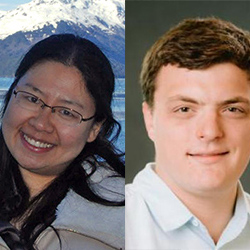Observational Astro Meeting: Ting Li & Matthew Digman

When:
Monday, November 25, 2019
2:00 PM - 3:30 PM CT
Where: 1800 Sherman Avenue, 7th Floor Conf. Rm, Evanston, IL 60201 map it
Audience: Faculty/Staff - Student - Post Docs/Docs - Graduate Students
Cost: Free
Contact:
Lisa Raymond
(847) 491-8646
Group: CIERA - Observational Astronomy Meetings
Category: Lectures & Meetings
Description:
Monday Observational Meetings for Northwestern University's Center for Interdisciplinary Exploration and Research in Astrophysics (CIERA), this week featuring:
Ting Li (Carnegie Observatories)
Title: The Southern Stellar Stream Spectroscopic Survey
Abstract: In this talk, I will present an ongoing spectroscopic program, the Southern Stellar Stream Spectroscopic Survey (S5), which maps newly discovered stellar streams with the fiber-fed AAOmega spectrograph on the Anglo-Australian Telescope. S5 is the first systematic program pursuing a complete census of known streams in the Southern Hemisphere, providing a uniquely powerful sample for understanding the building blocks of the Milky Way's stellar halo, the progenitors and formation of stellar streams, the mass and shape of the Milky Way's halo, and ultimately the nature of dark matter. In additional to observing stars in the stellar streams, we use spare fibers to conduct two auxiliary programs, a Milky Way halo survey as well as a low redshift galaxy survey. In particular, we serendipitously discovered one of the fastest hyper-velocity stars in the Galaxy at ~1700 km/s, ejected from Sgr A*, the supermassive black hole in the Galactic Center."
Host: Kerry Paterson
Matthew Digman (Ohio State University)
Title: LISA Galactic Binaries in the WFIRST Microlensing Survey
Abstract: Short-period galactic white dwarf binaries detectable by LISA are the only guaranteed persistent sources for multi-messenger gravitational-wave astronomy. Large-scale surveys in the 2020s present an opportunity to conduct preparatory science campaigns to maximize the science yield from future multi-messenger targets. The WFIRST microlensing survey will image seven fields in the galactic bulge approximately 40000 times each. Although the cadence is optimized for detecting exoplanets via microlensing, it is also capable of detecting eclipsing white dwarf binaries. I will present forecasts for the number of short-period binaries the WFIRST microlensing survey will discover and the implications for the design of electromagnetic surveys.
Host: Deanne Coppejans